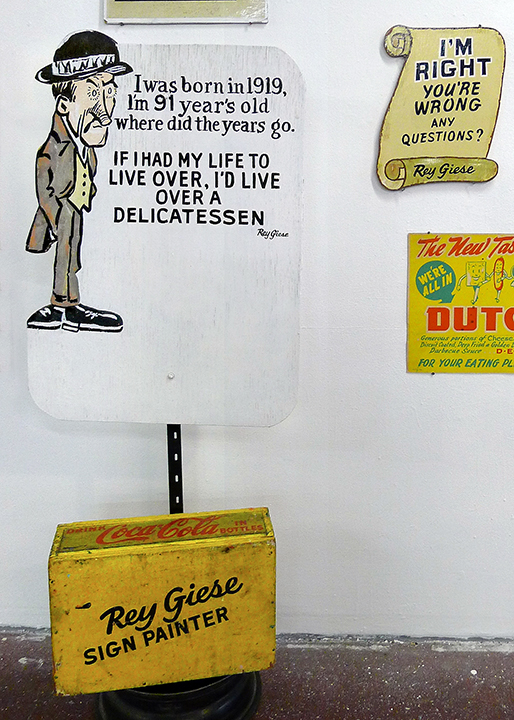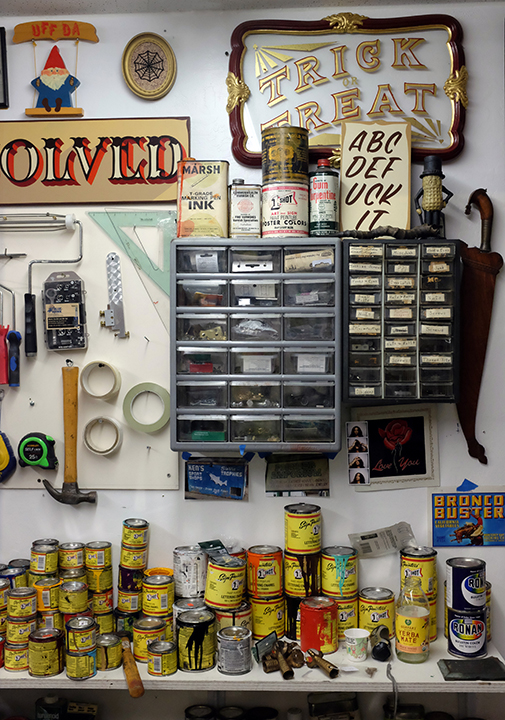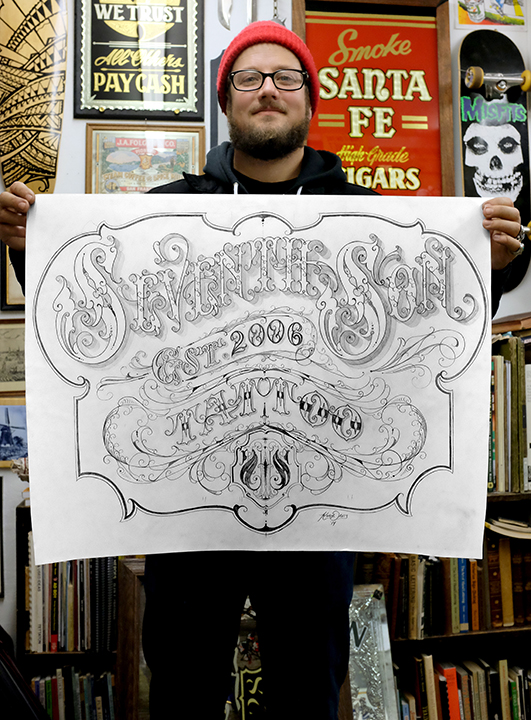For 73 years, Rey Giese painted the Valley of Heart’s Delight in letters, numbers and company logos. A skilled artisan whose craft was earned by years of apprenticeship, working as a journeyman and then finally branching out into his own business, Giese spent the 1930s and ’40s in what would come to be known as Silicon Valley honing his skills and personal style—one that he adhered to throughout his entire career, enduring passing trends and fickle tastes.
Giese was still working two weeks before his death, at the age of 93, in 2013. Whether or not he was aware of it, a new generation of sign painters revered him as a legend, and were committing themselves to keep the vanishing craft alive. In a tribute exhibition at KALEID Gallery in 2014, friends, clients and sign painters from up and down the California coast showed up with a variety of Giese artwork, vintage photos and plenty of good-humored stories. He was clearly beloved by all that knew him.

Ken Davis was one of them. An ardent admirer, Davis once met with Giese to inquire about purchasing one of his signs. Giese looked at him a bit confused, and said, “You’re a sign painter, why don’t you just make it?” Davis persisted: “I’d like something from you.” Giese just rolled his eyes, and said, “Okay.”
Davis was born in 1982, the very same year that the vinyl cutting plotter was established, thus causing the accelerated decline of the traditional sign trade; it was (and still is) faster and cheaper than hand-painting. Davis’ peers like to joke that he was born “in the ashes of sign painting,” but Davis has taken the torch from the purists of the past, like Rey Giese, and carried it into a digital age where its rarity is being appreciated as an art.
Davis grew up in Fremont, drawing replicas of comic-book logos like The Incredible Hulk and rusted brand names on the sides of freight trains that rolled through the neighborhood. An inclination toward subculture led him to visiting skateboard shops for their graphics, much like others might visit an art gallery. He felt his calling to do graphics and lettering for a living, but had no idea how to go about it. He was working in a shipping and receiving warehouse and really beginning to loathe it. “I started acting out and doing little subversive things to make me feel better about my day,” he says—things like building a secret skate ramp in the back of the warehouse and hiding out whenever he could. It was there that he read Two Year Autopsy by tattoo artist Grime. “All I could think,” recalls Davis, “was that this guy had it harder than most and is doing his dream… what’s my excuse?”
In 2003, Davis began practicing his lettering in secret and learned about the sign painter’s enamel 1 Shot. “I rushed over to an art store in downtown San Jose that I heard carried it,” he says. “They only carried three colors: white, ivory and dark brown. I bought all three… it’s a color palette I still use in my work all the time.”

As fate would have it, Davis soon met Josh Luke at an art show in a tattoo shop. Davis pointed to Luke’s “Trick or Treat” gold-leaf sign in the show and asked, “Can you show me how you do that?” Soon, they were hanging out, bonding over lettering and skateboarding. Luke worked at New Bohemia Signs, a 100% hand-painted sign shop, and when a vacancy came up at the small but soon-to-explode shop, they offered Davis an apprenticeship. “I was so excited,” Davis reports. “My very first job was to fill in all these circles, and it took me forever because I wanted to be so precise about it and do a good job.”
That sort of dedication is still with him today. Davis values meticulous technique and is disappointed by the “earn it ’til you learn it” attitudes of the internet age. “There’s a whole enthusiasm in making crafts that were lost during our parents’ generation, but the problem I see with that is that everything is so goddamned accessible online,” he says. “There’s no genuine appreciation for the steps needed to hone that craft. ‘Hey, I just took a three-part session on YouTube on how to do this… I’m going to start my own online business selling it.’ There’s a total disregard for other people’s pounds of flesh they gave in honing their skill.”
Davis continues: “Every artist or craftsperson I look up to doesn’t just see something and copy it. They’ve said to themselves, ‘I like that, but why do I like it? Let me look at the influences and go down that rabbit hole of history.’ They come back up with their own take on things, and their own reasons for doing what it is they’re doing.”
Davis remains unwavering in a commitment to giving his client work of great value. “I may come in with a migraine, but it won’t be because I was at the bar the night before. It’ll be because of the pressure I put on myself to deliver the best I can.” As for the many unseasoned sign painters charging questionable rates, Davis is concerned about their potential to “sour” the public on sign painting with their lack of skill. “You have to bring the quality that brought you to where you are, and you have to bring that quality every time. The only way to stay relevant in craft or art is to consistently be a monster,” he says. “To just consistently annihilate their senses.”

It’s with this reputation and fan base that Davis has been successfully self-employed for the past three years, dividing his time between on-location work for clients, commission work for customers and his own artistic work for art shows. But even these divisions are becoming blurry. He often has clients that reach out and say: “We like what you do, just do something for us.” This is a tricky line between the trade purists, whose motto is “It’s just a sign,” and the artists who are commissioned to execute their own vision and aesthetic.
But Davis has the respect of both camps. With the standards of the craft’s forebears on one hand and a quick wit and contemporary outsider attitude on the other—coupled with an active Instagram feed—he’s even been flown to Japan and the Netherlands for work (something he’s hoping to do more of). “As the Bay Area is being slashed and every open space is being built upon, I’m really wanting to move closer to nature. Keep my overhead low, travel more, and paint for people that appreciate what I do,” Davis says.
“This is it for me, it’s sacred. I take it very seriously because I don’t want to go back.”